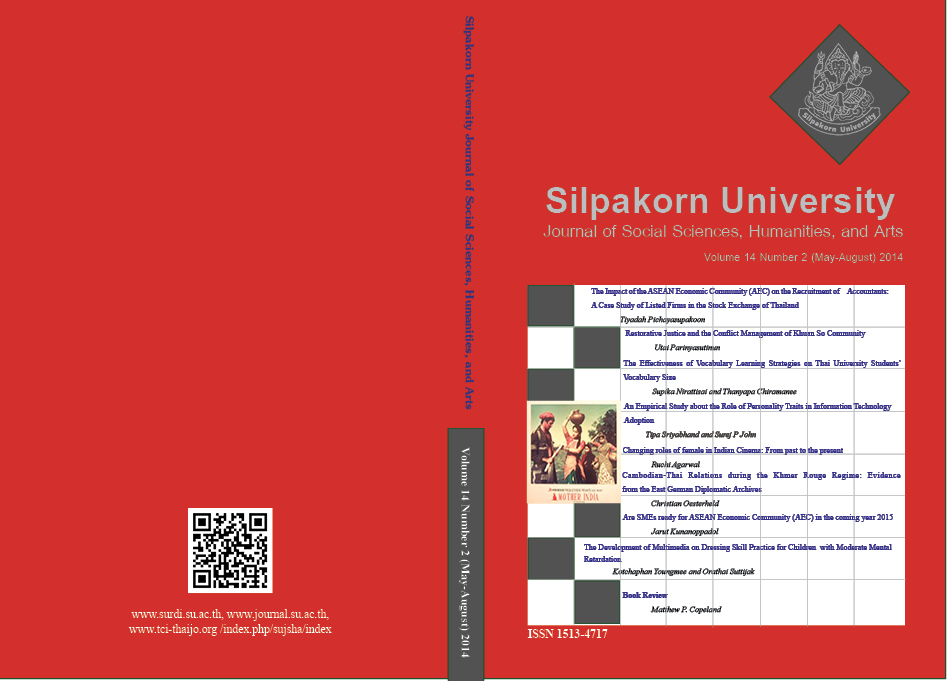The Development of Multimedia on Dressing Skill Practice for Children with Moderate Mental Retardation
Main Article Content
Abstract
The objectives of this study were 1) to develop the multimedia on dressing skill for the children with moderate mental retardation; and 2) tostudy the result learning of the multimedia used for improving dressing skills in children with moderate mental retardation. The sample group consisted of ten children with moderate mental retardation selected by simple sampling technique. Tools of this study were 1) the multimedia on dressing skill practice for the children with moderate mental retardation which had been designed and developed by the researcher; 2) an evaluation form on the quality of the multimedia implementation, and 3) a behavioral observation form on the children’s learning through the multimedia.Statistical techniques included percentage, means ( ), and standard deviation (S.D.).The outcomes suggested that;1. The development of the multimedia on dressing skill practice forthe children with moderate mental retardation designed and developed bythe researcher was verified for its quality at a very high level ( = 4.95,S.D.= 0.12).2. In term of features required the multimedia for the childrenwith moderate mental retardation, it was found that 1) the introduction should be designed and presented with the pictures looking familiar to the children in order to gain their attention and encourage them to learn;XXThe Development of Multimedia on Dressing Skill Practice 2) The activities should be clearly explained following the certain steps and the objectives in order to empower the children to demonstrate the constant learning; 3) Screen should be presented with thick and clear font and it should be colorful and neat in order to encourage the children’s perception; the pictures should also be clear and understandable, and look familiar representing the children’s daily life so that they can learn easily;the bottom should be easy for use and the multi media should not contain more than 3 bottoms; 4) In term of the function, the clear instruction should be provided and interact with the user as well as that the information should be well linked in a good sequence and easy for use. 3. The children’s learning outcome was increased after learning through the multi media. Overall, the multimedia was used to promote the children with moderate mental retardation to be more skillful in dressing and they showed an acceptable leaning behavior ( = 3.52, S.D. = 0.12). Most of the children became more accurate in placing the dressing itemon the right position of the cartoon character ranked from 1) Pant or Skirt,2) Shirt, 3) Shoes, 4) Socks, and 5) Hat or Hair ban. In this regard, it was affirmed that these 10 children demonstrate a good progress in their dressing skill after learning through the multimedia. Additionally, the quality of the multimedia was very high and it improve the children’s dressing skill in putting things at proper positions and more correct dressing after the children had learn constantly through the multimedia. Besides, the multimedia was proved to be applicable for the children with mental retardation because it is easy to be used, attractive,and colorful. The cartoon characters were designed and adapted from the children’s characteristics so they looked more attractive to the samplegroup and they were encouraged and concentrated to learn. The subjectsliked the multimedia, wanted to repeat using it, felt encourageous, and were willing to finish without sign of boredom.
Downloads
Article Details
All rights reserved. Apart from citations for the purposes of research, private study, or criticism and review,no part of this publication may be reproduced, stored or transmitted in any other form without prior written permission by the publisher.
References
Cronbach, Lee. J. (1990) Essentials of Psychology Testing. 5th ed. New York: Harper Collins Publishers Inc.
Dale, E. and Kauffman, E. (1950) Display for learning. New York: Dryden Press.
Department of Curriculum and Instruction Development, Ministry of Education. (2001) Multimedia for Education. Bangkok: Kurusapa Ladprao Press.
Hongsa, T. (2010) The Development of the Multimedia on “Dinosaur at Phu Khum Khao”, Kalasin Province. Maha Sarakham; Mahasarakham University Press.
Limtasiri, O. (n.d.) Teaching Special Children. Department of Curriculum and Instruction, Faculty of Education: Ramkhamhaeng University.
Phusi-Orn, S. (2008) SPSS Application for Research Data Analysis.Kalasin: Prasarn Publication.
Sirisookpaiboon, S. (1983) Teaching Practical Skill. Bangkok; King Mongkut's University of Technology North Bangkok Press. King Mongkut's University of Technology North Bangkok.
Sonkram, N. (2010) The Design and Development of Multimedia for Learning. Chulalongkorn University Press: Bangkok.
Tanthaluck, P. (1983) Principles of Design. Bangkok: Pitak Aksorn press.
Yoakam, G. A. and Simpson, R. G. (1954) Modern Methods and Techniques of Teaching. New York: The Macmillan Company.
Yodkampang, S. (1999) Instructional Document for the Joined Class between the Normal and Special Children. Nakhon Ratchasima province: the Special Education, Faculty of Education, Nakhon Ratchasima Rajabhat University.


